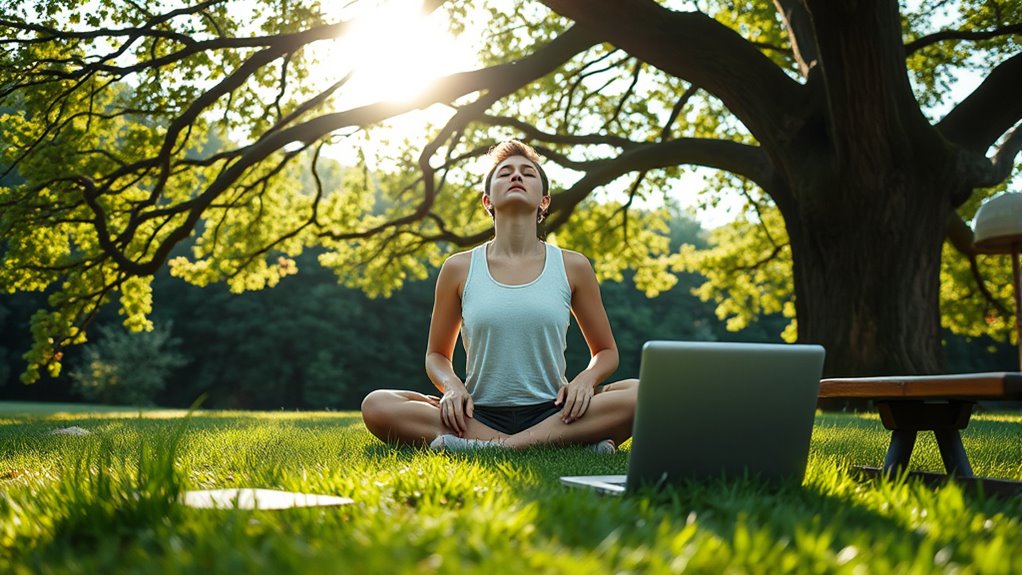Reducing your screen time through a digital detox helps you regain mental clarity and improves overall well-being. Set clear boundaries and designate tech-free zones, especially during meals or before bed. Use device features like timers and “do not disturb” modes to manage your digital habits intentionally. Incorporate mindfulness practices such as deep breathing to stay aware of your device use. Continuing further can help you uncover practical strategies for a healthier tech balance and a more focused, rested mind.
Key Takeaways
- Set clear daily screen time limits and schedule tech-free periods to prevent overexposure.
- Create designated tech-free zones, especially during meals, bedtime, and outdoor activities.
- Use device features like app timers and “do not disturb” modes to manage digital habits.
- Practice mindfulness techniques such as deep breathing or meditation to reduce digital overwhelm.
- Engage in offline activities and hobbies to promote mental clarity and overall well-being.

In today’s connected world, it’s easy to feel overwhelmed by constant notifications, social media, and endless screen time. The digital landscape is designed to grab your attention, but overexposure can lead to tech mindfulness challenges and screen fatigue. You might find yourself scrolling mindlessly, feeling drained and distracted, even when you’re not actively engaging with your devices. This persistent digital immersion can erode your ability to focus, relax, and enjoy real-world moments. Recognizing the signs of screen fatigue is the first step toward creating healthier tech habits. When your eyes feel tired, your mind is restless, or you struggle to concentrate, it’s a sign you need a break. Overuse of devices can also disrupt your sleep cycle, leading to fatigue that affects your overall well-being. Cultivating attention through mindful practices can strengthen your focus and reduce digital overwhelm.
To combat this, start by setting clear boundaries for your screen time. This isn’t about cutting out technology altogether but practicing tech mindfulness—being aware of how, when, and why you use your devices. For instance, designate specific times for checking social media or emails, and stick to these limits. Use features like app timers or “do not disturb” modes to help enforce these boundaries. Incorporating tech mindfulness into your routine makes you more intentional about your digital interactions, reducing unnecessary screen exposure and easing screen fatigue. When you consciously decide when to disconnect, you regain control over your mental space and reduce feelings of overwhelm.
Creating tech-free zones or periods during your day can work wonders. Consider establishing a no-device time during meals, right before bed, or during outdoor activities. This helps reset your mind and allows your eyes to rest from constant screen exposure. Practicing mindfulness techniques, like deep breathing or meditation, can also help you detach from digital distractions and center yourself. These practices enhance your awareness of how technology impacts your mood and energy levels, encouraging healthier choices.
Frequently Asked Questions
What Are the Best Alternative Activities During a Digital Detox?
During a digital detox, you should try outdoor adventures like hiking or biking, which reconnect you with nature and refresh your mind. You can also immerse yourself in creative hobbies such as painting, cooking, or playing an instrument to boost your well-being. These activities keep you engaged without screens, helping you find joy and relaxation while reducing your digital dependency. Embrace these alternatives for a healthier, more balanced lifestyle.
How Can Parents Encourage Children to Reduce Screen Time Effectively?
You can encourage children to reduce screen time by setting clear family boundaries and involving them in establishing rules. Use positive reinforcement to praise their efforts and successes. Offer fun, engaging alternatives like outdoor play, reading, or creative activities to replace screen time. Consistently reinforce these boundaries and celebrate their progress, helping kids develop healthier habits and enjoy a balanced lifestyle without feeling restricted.
Are There Specific Apps to Monitor and Limit Screen Usage?
Yes, there are specific apps to monitor and limit your child’s screen time. You can use app blockers like Qustodio, Norton Family, or Family Link to set daily limits, restrict access to certain apps, and track usage. These tools give you control, helping your child develop healthier habits. By actively managing screen time with these apps, you encourage a balanced digital lifestyle and reduce potential overuse.
Can Digital Detox Improve Mental Health in the Long Term?
Yes, a digital detox can considerably boost your mental health in the long term. Imagine waking up refreshed, less anxious, and more focused—these are just some of the mental health benefits you’ll experience. By reducing screen time, you create space for genuine connections and self-care, leading to lasting positive effects. Don’t underestimate the power of stepping back; your mind will thank you for it over time.
How Do Workplaces Implement Screen Time Reduction Policies?
You can implement screen time reduction policies in your workplace by setting clear guidelines on device usage and encouraging regular breaks. To boost employee engagement, involve staff in creating these policies, making them feel valued. Enforce rules consistently and openly communicate their benefits. Offering alternatives like face-to-face meetings or outdoor breaks helps reinforce the policy, ensuring it’s effective and promotes overall well-being.
Conclusion
So, go ahead—put down that device and embrace the “real world.” After all, who needs meaningful face-to-face conversations or fresh air when you can scroll endlessly, right? Remember, your social life isn’t on your screen; it’s right outside your door. So, detox now before your digital obsession turns you into a walking, talking emoji. Trust me, your soul (and your friends) will thank you.









